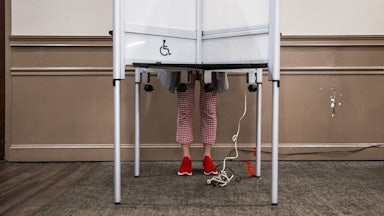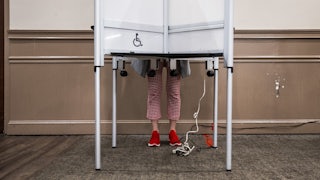When Nancy Pelosi visited Taiwan this summer, China immediately put high-level climate talks between its government and the United States on ice. This week there’s been a thaw. President Biden met with Xi Jingping at the G20 on Monday, and the two agreed to “empower key senior officials to maintain communication and deepen constructive efforts,” including on climate. U.S. climate envoy John Kerry has meanwhile been speaking to his Chinese counterpart, Xie Zenhua, at U.N. climate talks in Egypt. That detail was confirmed with all the enthusiasm of middle schoolers passing notes about a new crush: “Yes,” Kerry told CNN, “we are talking.”
As the world’s first and second-largest emitters, respectively, China and the U.S. have what is arguably the most important bilateral relationship on—and for—the planet. As Russian aggression ramps up, it’s certainly good news that Beijing and Washington have agreed on the importance of keeping lines of communication open—even as China’s government continues to turn inward and close ranks amid rising authoritarianism and domestic turmoil. There are subtle signs that the mood in Washington may be starting to shift away from the last few years of competitive antagonism.
Biden’s signature legislative agenda, the American Jobs Plan, was pitched as a way to take on “the great challenges of our time: the climate crisis and the ambitions of an autocratic China.” That framing—bent on decoupling the U.S. from China—was largely absent by the time a shrunken version of it passed as the Inflation Reduction Act this summer. What became the CHIPS Act once included a raft of hawkish anti-China measures championed by prominent Democrats like Foreign Relations Committee Chair Bob Menendez. Those were stripped to yield a more straightforward package to provide funds for R&D and manufacturing. The White House is now striking a different tone as well. “As the leaders of our two nations, we share a responsibility, in my view, to show that China and the United States can manage our differences, prevent competition from becoming anything ever near conflict, and to find ways to work together on urgent global issues that require our mutual cooperation,” Biden said in remarks before his meeting with Xi.
That’s not to say things aren’t still plenty tense. Taiwan remains a hotly contested issue, as do tariffs. Just last week, the Biden administration announced a sweeping new ban on the sale of chips and advanced manufacturing components to China that are needed to make semiconductors.
Less hawkish members of the national security establishment, including Kerry, have maintained that the U.S. and China could continue a dialogue on climate even if communication on other fronts broke down. “That never seemed realistic to me,” said Tobita Chow, director of Justice Is Global, a project of the community-organizing network People’s Action focused on progressive foreign policy. “Clearly if Chinese leaders come to believe we’re undermining really core priorities, that’s going to have an impact on our ability to collaborate on climate.” Democrats are probably going to have to choose between treating China as a sworn enemy and collaborating on the energy transition and other climate issues.
The former approach hasn’t been an obvious winner, politically. Tim Ryan made a Midwest manufacturing revival central to his campaign for the Ohio Senate seat vacated by Republican Rob Portman, which heavily targeted Trump voters. To do so, he embarked on an arms race of anti-China rhetoric with America First opponent J.D. Vance, including a controversial “One Word” ad blaming China for Ohio’s economic woes. “Of course, I’m not for any violence,” Ryan told The New Yorker’s E. Tammy Kim when asked about accusations of sinophobia. “But we also have to have a conversation about what China’s trying to do.” He lost by a narrower margin than expected: nearly seven points. A Democrat winning Portman’s seat was always an uphill battle. But running on anti-China messaging also didn’t prove to be a skeleton key for winning Republicans over to the other side.
Things have changed since talks broke down over the summer. The U.S. now actually has its own industrial policy, however limited: the Inflation Reduction Act. Some experts think this alone could have put the U.S. political establishment in better spirits. “Pointing the finger at a perceived foreign threat can be a way to cope with anxieties leaders feel about the domestic situation and failures in domestic policy,” Chow said. At least for now, things here look surprisingly stable: The U.S. has passed a major bill aimed at building up a low-carbon economy, and voters don’t seem too keen on handing full power over to anti-democratic zealots in the GOP.
“Part of the hostility and frustration in Washington with regards to China probably came from the fact that we didn’t have very much to bring to the table. We didn’t have a domestic industrial strategy,” said Jonas Nahm, a political scientist at Johns Hopkins who researches green industrial policy in China, Europe, and the U.S. “We were watching China gobble up more and more sectors. The U.S. response was to say, ‘China can’t have anything.’ That’s not a way to run global supply chains.”
When it comes to renewables, China’s dominance is especially intense: China now accounts for more than 30 percent of the world’s total installed capacity of renewable power generation and makes 70 percent of the solar modules worldwide. Given how rapidly the U.S. needs to transition off fossil fuels to meet its climate goals, even a radically aggressive clean energy manufacturing buildout in the U.S. would still entail importing Chinese-sourced renewables components for years to come. The Inflation Reduction Act was not radically aggressive, so we’ll probably still need to import Chinese-made parts. But being able to point to these policies in the IRA that will create jobs in low-carbon sectors will likely make rapid decarbonization—and the associated imports—an easier political sell to American voters. Demand for clean energy is growing globally, after all, with plenty of room for both countries to reap the benefits. The experience of trying to pass a modest suite of tax credits through Congress may have offered a corrective to the idea that climate policy should recreate renewables supply chains that already exist elsewhere—even as U.S. policymakers work toward some much-needed improvements. The IRA also leverages “non-market” tools that have been a staple of Chinese industrial policy, including the kind of local content requirements that U.S. officials have criticized in the past.
Though it’s still too soon to tell, Nahm hopes that recent progress in Congress “might allow the U.S. to be a little more self-confident and generous in this relationship, and accept that we might have to buy things from China.” Whatever China does, the U.S. working on its own issues is undoubtedly a good start—for American policy, for the bilateral relationship, and for the planet.










